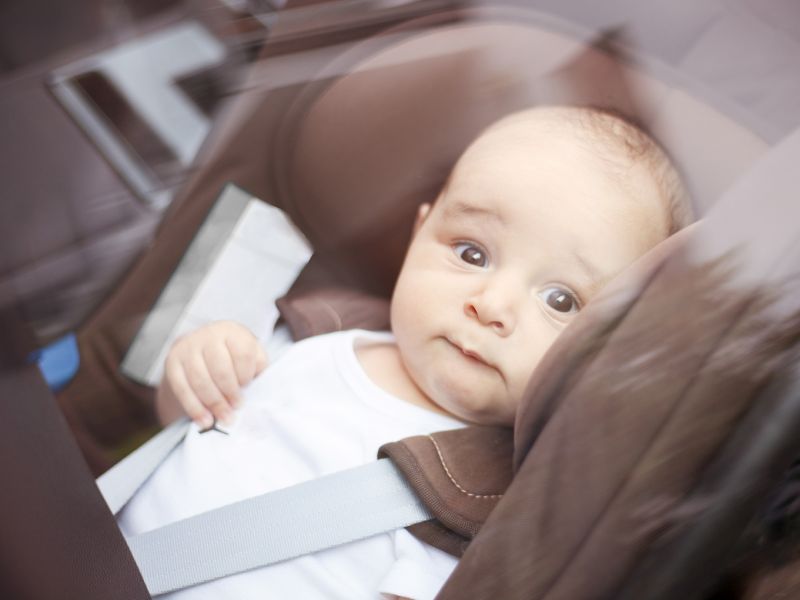Putting Your Child to Sleep in a Car Seat Can Be Deadly
By Alan MozesHealthDay Reporter

MONDAY, May 20, 2019 (HealthDay News) -- A car seat is the safest place for an infant while traveling in a car. But putting your baby to sleep in a portable car seat at home can be deadly, a new study warns.
Over a decade, nearly 12,000 babies in the United States died while sleeping -- about 3% of them while in an "infant sitting device," such as a car seat, stroller, swing or infant seat, according to the study of U.S. National Center for Fatality Review and Prevention data.
Car seats accounted for the vast majority -- 63% -- of such deaths. And 9 out of 10 car seat deaths occurred while the seat was being used as a makeshift crib outside the car.
"We were very surprised to find that less than 10% of the deaths in car seats happened when the car seat was being used in a car or other vehicle and the infant was strapped in appropriately," said study author Dr. Jeffrey Colvin, an associate professor of pediatrics at Children's Mercy Hospital in Kansas City, Mo.
"Instead, we found that the most of the infant deaths in car seats happened in the child's home," he added.
The deaths fall under the umbrella of Sudden Infant Death Syndrome (SIDS), and accidental suffocation and/or strangulation in bed.
Rather than get alarmed about car seat safety, Colvin said parents should take steps to protect their babies.
Whether baby is asleep or awake, car seats are the safest place for them when they're in the car. But once babies are outside the vehicle, they should sleep in a crib or bassinet, he said.
American Academy of Pediatrics (AAP) guidelines say babies should sleep alone, on their backs, on a firm surface and without soft bedding. AAP specifically "discourages routine sleeping in sitting devices."
The data reviewed -- collected between 2004 and 2014 -- found that almost two-thirds of sleep-related infant deaths during that time involved improper use of a sitting device.
The 348 identified deaths occurred in babies at an average age of 2 months. More than a third (35%) involved a bouncer, swing or similar device, and 2% occurred in a stroller.
The largest number of deaths -- 219 -- involved babies sleeping in a car seat. More than half of these (52%) occurred inside the parent's home. Only 10% of the car seat deaths occurred when a seat was being used "as directed," that is, while protecting a baby in a moving vehicle, the study found.
Colvin's team did not investigate why leaving an infant in a car seat outside a vehicle increases SIDS and accidental suffocation risk.
The researchers outline their findings in the July issue of Pediatrics.
Dr. Guohua Li, director of the Center for Injury Epidemiology and Prevention at Columbia University in New York City, reviewed the findings.
While emphasizing that car seats are not designed as sleeping devices, he said researchers did not prove that improper use causes infant death.
"This study provides some suggestive evidence that improper use of car seats as a sleeping device might pose a risk for sudden unexpected infant death or sudden infant death syndrome," Li said. "But it does not prove that car seats are a contributory factor for these infant deaths, or that sleeping in a car seat is more dangerous than sleeping in a crib or bassinet for infants."
Li stressed that used properly, car seats can reduce the risk of crash deaths for babies and toddlers by more than 50%.
That said, however, he agreed that "it is sensible to educate the general public about the proper use of car seats, and warn parents and other caregivers against using car seats as a sleeping device."
More information
For information about the proper use of infant car seats, visit Consumer Reports.

The news stories provided in Health News and our Health-E News Newsletter are a service of the nationally syndicated HealthDay® news and information company. Stories refer to national trends and breaking health news, and are not necessarily indicative of or always supported by our facility and providers. This information is provided for informational and educational purposes only, and is not intended to be a substitute for medical advice, diagnosis, or treatment.

